Lawncare Chemicals Q&A
- Milorganite AgronomistMay 30, 2020
What Lawn care Chemicals Should I Use on My Lawn?
I often get questions from customers regarding the use of a variety of chemically-based lawncare products, such as fertilizers, herbicides, insecticides, pesticides and fungicides. Questions range from how to choose the right product, how much to use and when it should be applied. I’ve provided some guidance here to help.
Always read and follow manufacturers’ directions for all lawncare products. You’ll find information about the product’s active ingredients, the problem it addresses, necessary personal protective equipment (PPE), as well as proper application and clean-up.
As a general rule, only apply the lawncare products that are necessary to address the problem at the lowest effective rate possible. Applying an excess of chemicals can have a number of potential harmful effects on humans, pets, the soil’s ecosystem, beneficial insects, wildlife, aquatic creatures and the environment, particularly waterways.
It’s also important to familiarize yourself with local guidelines and restrictions regarding the application of lawncare products, including amounts and time of year a product can be applied. Guidelines are in place to protect both you and the environment. If you have questions regarding the use of lawn care chemicals, as well as state and local restrictions, I recommend you contact your local extension office.
Before applying any chemicals to your lawn, consider more environmentally friendly lawn care practices and products.
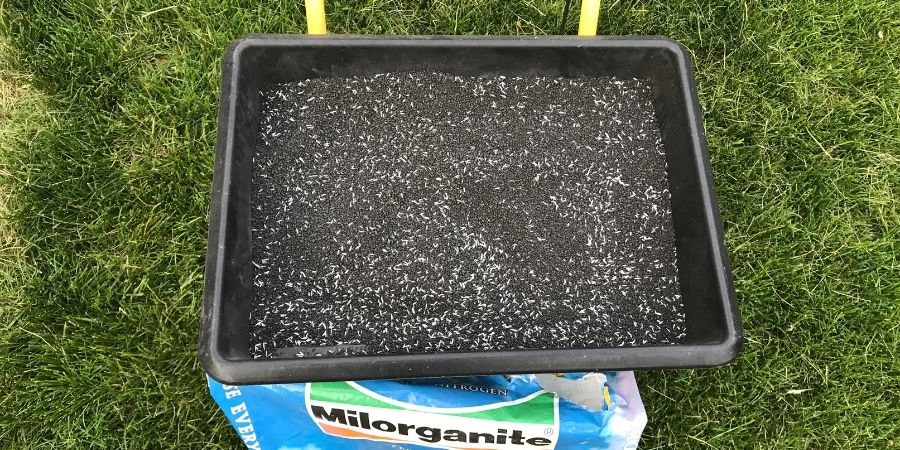
Milorganite and grass seed in a spreader
Fertilizer
What is a Lawn Fertilizer?
Fertilizers are used to replenish nutrients essential for plant growth that are lacking in the soil. Applying the proper amount is important, as excess nutrients can contribute to runoff and contaminate groundwater, streams, rivers and lakes, increasing the chance of drinking water contamination. In lakes and ponds, excess nitrogen and phosphorus from runoff can promote overwhelming weed growth and cause algae bloom, which can kill aquatic plants and creatures.
What Fertilizer Should I Use on My Lawn?
Fertilizers typically include nitrogen (N), phosphorus (P) and potassium (K), and are used to replenish nutrients lacking in the soil that plants need.
Nitrogen is important to a plant’s overall health. Phosphorus aids in developing strong root systems, as well as improves blooming, fruit growth and seed production. It also helps increase disease resistance when used in the proper amount. Potassium promotes optimum plant growth and improves water retention and disease resistance. Fertilizers may also contain secondary and micronutrients, also essential to plant grown in very small quantities.
Look for fertilizers that are low in slow-release, water-insoluble nitrogen, such as Milorganite.
Fertilizers can be synthetic (inorganic) or made from organic materials, which are those derived from organic materials and are generally safer for humans, pets and the environment. Consider using less-toxic alternatives to lawncare chemicals, such as organic fertilizers, naturally derived fertilizers, compost or composted manure to provide needed nutrients.
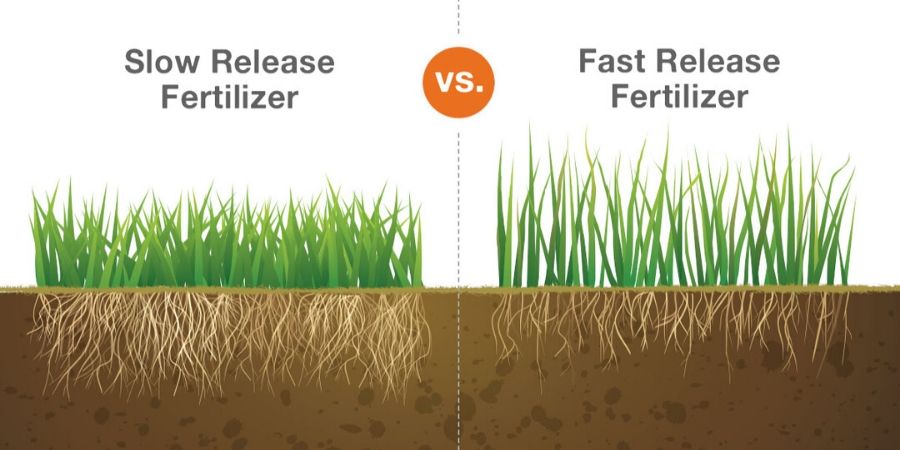
Compost and composted manure are balanced mediums derived from natural materials that provide both nitrogen and soil-enhancing properties. For instance, applying organic matter, such as leaving grass clippings on the lawn, will likely provide the necessary secondary and micronutrients. (I do not recommend using raw manure, as it often contains pathogens that are harmful to humans and pets.)
Fertilizers do not contain pesticides or herbicides unless otherwise indicated. Weed and feed products contain both fertilizer and weed-killing herbicides.
How much Fertilizer Should I Use?
Fertilizer feeds the soil so that grass gets what nutrients it needs.
First, you’ll need to determine what nutrients are lacking in the soil. Contact your local extension office to see if they offer soil analysis. If the analysis indicates nutrients are present in sufficient amounts, there’s no need to apply those nutrients. It will save time and money and, most importantly, reduce the risk of nutrient runoff.
Although you may be tempted to apply “a little extra” nitrogen, whether synthetic or not, this is a case where more is not better. Excess nitrogen encourages blade growth at the expense of a strong root system, which weakens plants because the roots can’t keep up with top growth. It may also lead to nutrient leaching, runoff, or may stress the plant out to the point of making it more susceptible to disease issues.
Choose a fertilizer that has the correct nutrients to compensate for those depleted in the soil.
When Should I Put Down Lawn Fertilizer?
Fertilizer should be applied when your lawn needs it the most. Matching applications to the growth cycle of grass is most effective by providing nutrients when the grass needs it the most.
A rule-of-thumb, fertilizers such as Milorganite, should be applied four times a year around the major holidays, including Memorial Day, Fourth of July and Labor Day, depending on where you live.
Herbicides
What are Herbicides?
Herbicides used on lawns are generally selective, targeting and killing specific weeds either before or after they’re growing. Others are non-selective and kill all vegetation, including your entire lawn if you choose the wrong product!
What Herbicide Should I Use on My Lawn?
There are two types of herbicides available and may be sold as either a liquid or granule. Pre-emergent herbicides kill weed seedlings as they emerge, so it should be put down before seeds germinate. Post-emergent herbicides target weeds that are already growing and requires the product to be in contact with the weed to be effective.
Read herbicide packaging very carefully. Selective herbicides may also kill certain grass varieties and non-selective herbicides kill all vegetation.
Weed and feed products are a combination of fertilizer and herbicides. Don’t apply additional herbicides to your lawn if you’ve already applied a weed and feed product.
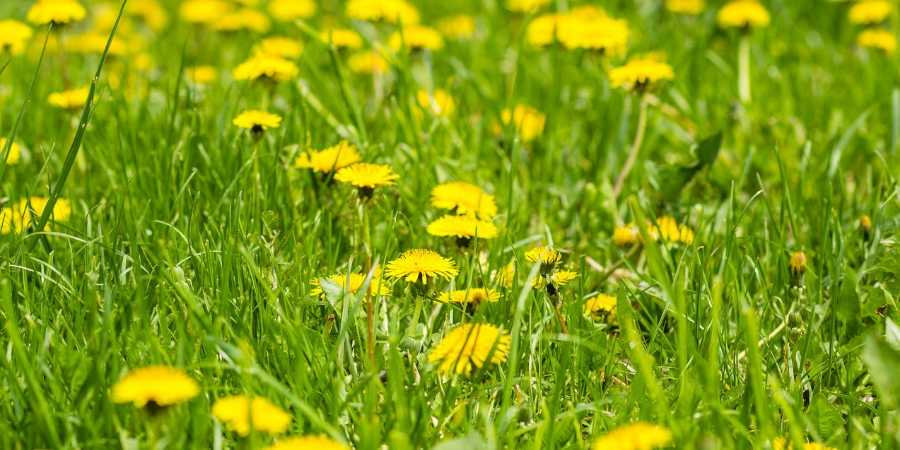
Dandelion weed
How much Herbicide Should I put On My Lawn?
If there are just a few weeds, consider pulling them by hand rather than applying an herbicide. A moderate number of weeds may require spot treatment with a pre-mixed, post-emergent herbicide. Lawns with an excessive number of weeds may call for a complete application of herbicide.
Follow all manufacturer directions for proper amounts of herbicide to use, as well as application methods and required personal protective equipment (PPE).
When Should I put down herbicide?
The best times to apply either a pre-emergent or post-emergent herbicide depends on your local climate. When to apply a pre-emergent herbicide depends on soil temperate—it should in the 50–55 degree range. You can determine the soil temperature online, contact your local extension office or use a meat thermometer with a 3” probe.
In cooler climates, spring and fall are the best time of year to apply a pre-emergent herbicide. A reapplication in spring will help the number of summer weeds. Fall application targets winter annual weeds that germinate in the fall.
In warmer climates, pre-emergents can be applied in spring to reduce summer weeds and again in fall to reduce weeds that grow in winter.
Apply post-emergent while summer weeds are actively growing, as it has to be in contact with the weed. In warmer climates, a post-emergents can be applied while winter weeds are actively growing.
Insecticides and Pesticides
What are Insecticides and Pesticides?
Insecticides are used to kill insects, while pesticides target critters. Both should be used judiciously.
Although formulated to kill a specific insect or range of insects, insecticides can also be harmful to a significant number of garden insects that are not harmful and are beneficial to the ecosystem, such as pollinators and those that feed on more harmful insects.
Careful selection and application of pesticides is also important, to avoid harming non-target wildlife and animals, including pets. Consider non-chemical means of controlling insects and pests.
What Pesticide or Insecticide Should I Use?
First, identify the cause of the problem you’re seeing. Treating with an insecticide when the problem is actually an animal or disease does nothing to address the problem, while introducing unnecessary chemicals to your lawn and the environment.
Choose a product that addresses the specific insect or pest problem you’ve identified.
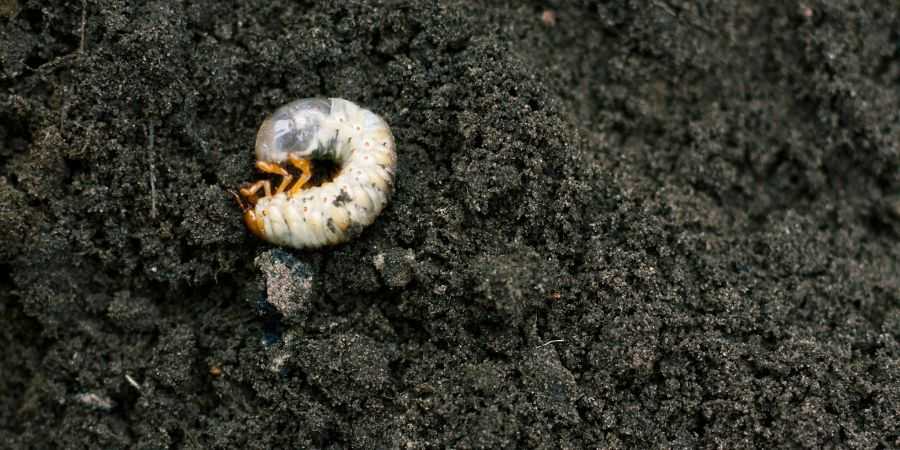
Grub
How much Pesticide or Insecticide Should I Use on My Lawn?
As always, follow manufacturer guidelines and use insecticides and pesticides that target your specific problem insect or pest you’ve identified at the lowest effective level. Apply product only when and where it’s needed.
When Should I use Pesticides or Insecticides?
The best time of year to apply insecticides and pesticides depends on the insect or pest. Some insects and pests may be addressed year-round.
Some insecticides are formulated to target specific insects at a particular phase of their lifecycle. Grubs are a good example. One active ingredient is needed to kill adult grubs, while another is needed, at a different time of year, to kill grubs in their pupal stage.
Fungicides
What are Fungicides?
Fungicides are used to either kill or prevent fungi from growing. In addition to mushrooms, fungi you may find infecting your lawn include plant diseases such as dollar spot, leaf spot, rusts and molds.
Fungi can be a year-round problem. You may find fungi-related diseases during cool, wet weather, but surprisingly you may also find some fungi species in your lawn during drought and excessive heat.
Prevention is the best way to avoid fungi from damaging your lawn. Lawn care practices can reduce the chance of fungi from establishing in your lawn. Water early in the day to help grass blades dry before diseases can settle in. Mow at the proper height and rinse the mower after cutting the grass to help prevent diseases from spreading.
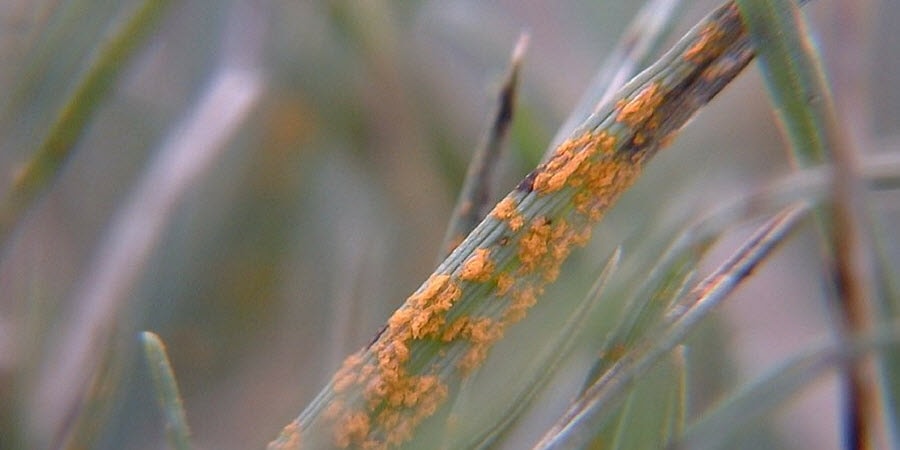
Rust Lawn Disease
What Fungicide Should I use on My Lawn?
Grass variety, season, climate and region all impact which fungi species may be infecting your lawn. Confirm that the problem is being caused by a fungus, and which one, before deciding on a treatment plan. Some insects cause damage that may be mistaken for fungi damage.
Fungicides are either preventive, which prevents grass from being infected, or curative, which stops or slows a fungal disease from spreading. Preventive fungicides should be used to help prevent the return of previously identified fungi.
Fungicides can be found in both granular and liquid forms. There are a few differences in fungicides to consider to help you select the best one for your lawn’s problem.
Ensure the fungicide you purchase will treat the specific type of fungus present in your lawn.
How Much Fungicide Should I Use?
First try non-chemical means to manage fungi in your lawn. Lawn maintenance practices can help reduce the opportunity for fungi to infect your lawn. Avoid applying excess nitrogen, rake fallen leaves and regularly dethatch your lawn and follow proper lawncare practices.
Follow manufacturer directions for application, proper PPE and clean-up.
When Should I apply a Fungicide?
When to apply a fungicide depends on the type of fungi and whether you’re applying a preventive or curative fungicide.
SUMMARY
Use natural methods whenever possible to address problem areas in your lawn. Although I prefer more natural means of lawn care, there are times when chemical-based products are necessary, including fertilizers, herbicides, insecticides, pesticides and fungicides.
When you see a problem area, the first step is to identify the culprit. Sometimes damage from lawn diseases, insects and pests can look very similar. Select products that specifically address the problem you’ve identified to help keep unnecessary chemicals off your lawn and out of the environment, and use the least amount possible to address the problem.

